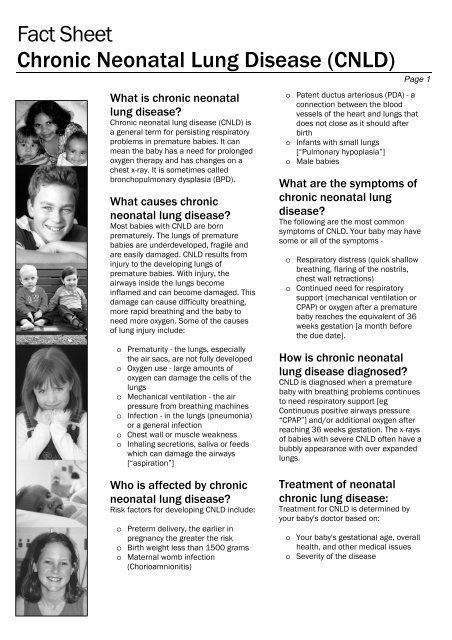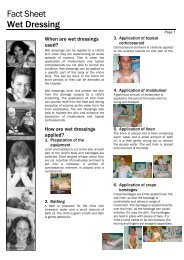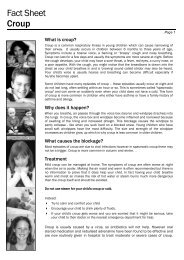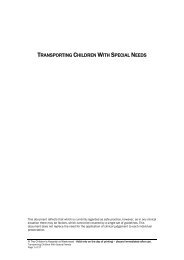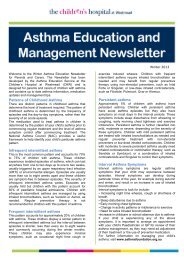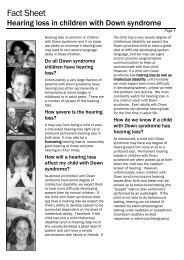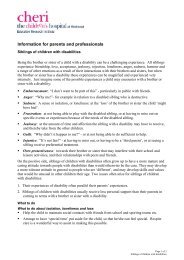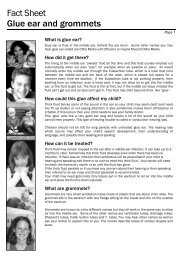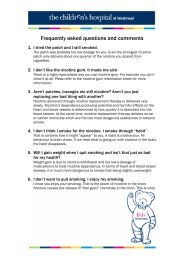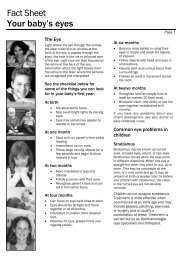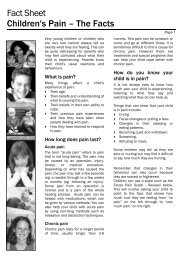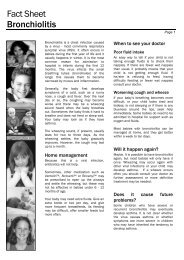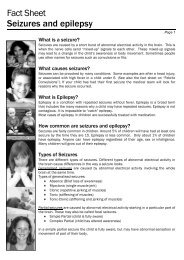Fact Sheet Chronic Neonatal Lung Disease - Kids Health @ CHW
Fact Sheet Chronic Neonatal Lung Disease - Kids Health @ CHW
Fact Sheet Chronic Neonatal Lung Disease - Kids Health @ CHW
You also want an ePaper? Increase the reach of your titles
YUMPU automatically turns print PDFs into web optimized ePapers that Google loves.
<strong>Fact</strong> <strong>Sheet</strong><br />
<strong>Chronic</strong> <strong>Neonatal</strong> <strong>Lung</strong> <strong>Disease</strong> (CNLD) Page 1<br />
xcvxcvxcv<br />
What is chronic neonatal<br />
lung disease?<br />
<strong>Chronic</strong> neonatal lung disease (CNLD) is<br />
a general term for persisting respiratory<br />
problems in premature babies. It can<br />
mean the baby has a need for prolonged<br />
oxygen therapy and has changes on a<br />
chest x-ray. It is sometimes called<br />
bronchopulmonary dysplasia (BPD).<br />
What causes chronic<br />
neonatal lung disease?<br />
Most babies with CNLD are born<br />
prematurely. The lungs of premature<br />
babies are underdeveloped, fragile and<br />
are easily damaged. CNLD results from<br />
injury to the developing lungs of<br />
premature babies. With injury, the<br />
airways inside the lungs become<br />
inflamed and can become damaged. This<br />
damage can cause difficulty breathing,<br />
more rapid breathing and the baby to<br />
need more oxygen. Some of the causes<br />
of lung injury include:<br />
o Prematurity - the lungs, especially<br />
the air sacs, are not fully developed<br />
o Oxygen use - large amounts of<br />
oxygen can damage the cells of the<br />
lungs<br />
o Mechanical ventilation - the air<br />
pressure from breathing machines<br />
o Infection - in the lungs (pneumonia)<br />
or a general infection<br />
o Chest wall or muscle weakness<br />
o Inhaling secretions, saliva or feeds<br />
which can damage the airways<br />
[“aspiration”]<br />
Who is affected by chronic<br />
neonatal lung disease?<br />
Risk factors for developing CNLD include:<br />
o Preterm delivery, the earlier in<br />
pregnancy the greater the risk<br />
o Birth weight less than 1500 grams<br />
o Maternal womb infection<br />
(Chorioamnionitis)<br />
o Patent ductus arteriosus (PDA) - a<br />
connection between the blood<br />
vessels of the heart and lungs that<br />
does not close as it should after<br />
birth<br />
o Infants with small lungs<br />
[“Pulmonary hypoplasia”]<br />
o Male babies<br />
What are the symptoms of<br />
chronic neonatal lung<br />
disease?<br />
The following are the most common<br />
symptoms of CNLD. Your baby may have<br />
some or all of the symptoms -<br />
o Respiratory distress (quick shallow<br />
breathing, flaring of the nostrils,<br />
chest wall retractions)<br />
o Continued need for respiratory<br />
support (mechanical ventilation or<br />
CPAP) or oxygen after a premature<br />
baby reaches the equivalent of 36<br />
weeks gestation [a month before<br />
the due date].<br />
How is chronic neonatal<br />
lung disease diagnosed?<br />
CNLD is diagnosed when a premature<br />
baby with breathing problems continues<br />
to need respiratory support [eg<br />
Continuous positive airways pressure<br />
“CPAP”] and/or additional oxygen after<br />
reaching 36 weeks gestation. The x-rays<br />
of babies with severe CNLD often have a<br />
bubbly appearance with over expanded<br />
lungs.<br />
Treatment of neonatal<br />
chronic lung disease:<br />
Treatment for CNLD is determined by<br />
your baby's doctor based on:<br />
o Your baby's gestational age, overall<br />
health, and other medical issues<br />
o Severity of the disease
<strong>Fact</strong> <strong>Sheet</strong><br />
<strong>Chronic</strong> <strong>Neonatal</strong> <strong>Lung</strong> <strong>Disease</strong> (CNLD) Page 2<br />
xcvxcvxcv<br />
o Your baby's response to certain<br />
medications, procedures, or<br />
therapies<br />
o Presence of complications such as<br />
reflux and aspiration, pulmonary<br />
hypertension or sleep disordered<br />
breathing<br />
o How much oxygen your baby needs<br />
and how long he/she has needed it<br />
Treatment of CNLD may include:<br />
o Extra oxygen (to make up for the<br />
decreased breathing ability of the<br />
damaged lungs)<br />
o Breathing support (CPAP) with<br />
gradual weaning as the baby's lungs<br />
grow<br />
o Medications, such as puffers, which<br />
may help to open the airways<br />
(bronchodilators) or reduce<br />
inflammation (steroids)<br />
o Limiting amounts of fluids and<br />
giving a medication (diuretic) to help<br />
the baby pass any excess fluid<br />
which can worsen breathing<br />
o Increased nutrition (to help the baby<br />
and the lungs grow)<br />
o Immunisation against lung infection<br />
by respiratory syncytial virus (RSV)<br />
CNLD can be a long-term condition.<br />
Some babies with CNLD require extra<br />
oxygen support for several months.<br />
Some babies will continue to require<br />
oxygen when they go home from the<br />
hospital. Most babies who go home on<br />
oxygen won’t need it anymore by the end<br />
of their first year of life. Babies with<br />
CNLD may have a higher risk of<br />
respiratory infection and may have to be<br />
re-hospitalised- the most likely reason<br />
being for a viral chest infection called<br />
bronchiolitis.<br />
This fact sheet is for education purposes only.<br />
Please consult with your doctor or other health professional<br />
to make sure this information is right for your child. This document was reviewed on 14 th September 2010.<br />
www.chw.edu.au www.sch.edu.au www.kaleidoscope.org.au<br />
© The Children’s Hospital at Westmead, Sydney Children’s Hospital, Randwick & Kaleidoscope * Hunter Children’s <strong>Health</strong> Network 2010


